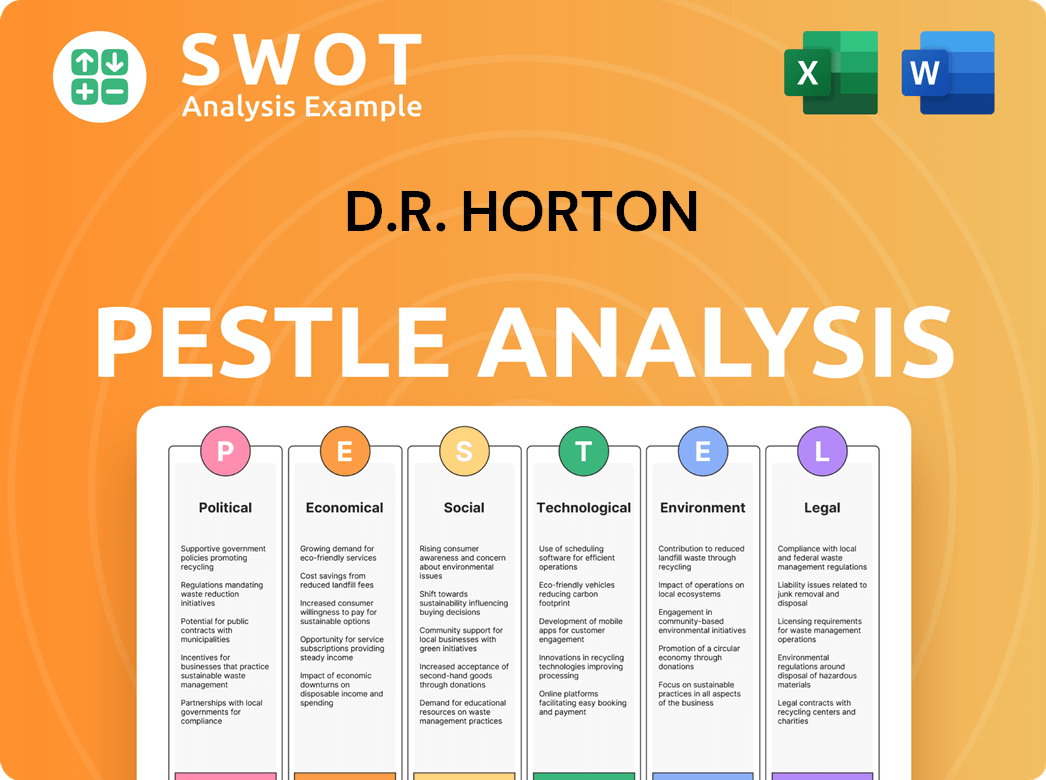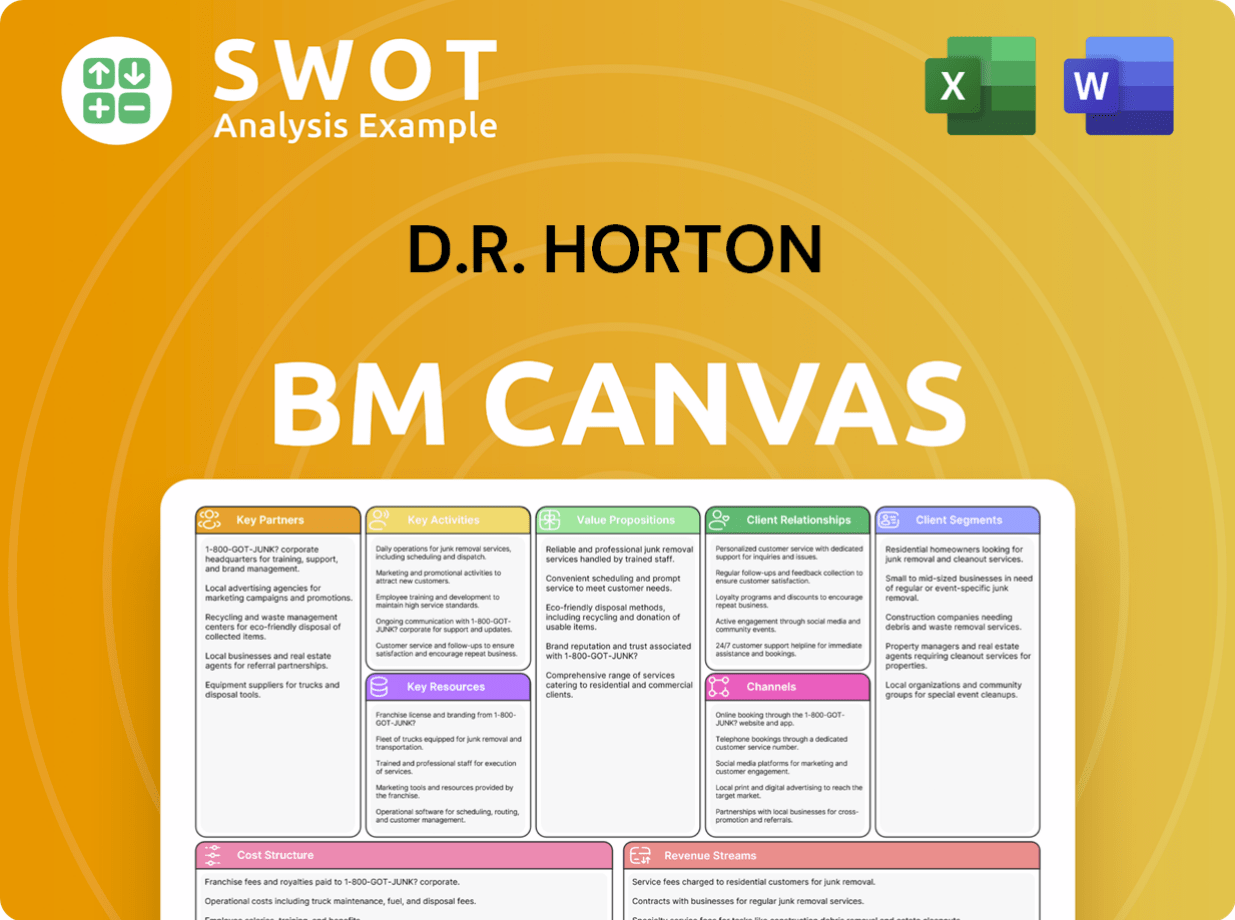D.R. Horton Bundle
Can D.R. Horton Maintain Its Dominance in the Ever-Changing Homebuilding Market?
D.R. Horton, a titan in the U.S. homebuilding industry since 1978, has consistently adapted to market dynamics, growing from a regional builder to the nation's largest by volume. Its strategic approach has enabled it to thrive across economic cycles, expanding its reach to 119 markets across 33 states by late 2024. This success story, however, exists within a fiercely competitive environment, making a deep dive into its competitive landscape essential.

Understanding D.R. Horton's D.R. Horton SWOT Analysis is vital for investors and strategists alike. This analysis will explore D.R. Horton's market position, dissecting its key rivals and distinct competitive advantages within the homebuilding market. We will examine the company's strategies for navigating housing market trends and its financial performance compared to competitors, providing critical insights into its ability to maintain its leadership in the real estate industry.
Where Does D.R. Horton’ Stand in the Current Market?
D.R. Horton's core operations center on the construction and sale of single-family homes, making it a significant player in the homebuilding market. The company caters to a wide range of buyers, including first-time homebuyers, move-up buyers, and active adults, ensuring a broad market reach. This approach allows the company to maintain its position as the largest homebuilder in the United States by volume.
The value proposition of D.R. Horton lies in its ability to offer a diverse range of housing options across different price points and demographic segments. Through brands like Express Homes and Freedom Homes, the company provides affordable housing solutions while also catering to the active adult market. This diversification helps D.R. Horton navigate varying market demands and maintain its competitive edge within the real estate industry.
D.R. Horton has held the title of the largest homebuilder in the U.S. by volume for 22 consecutive years as of fiscal year 2024. The company's extensive geographic presence, spanning 119 markets across 33 states, particularly in the Sunbelt region, is a key factor in its market share. D.R. Horton's financial health is robust, with total revenues of $36.6 billion reported for fiscal year 2024. This financial strength provides advantages in land acquisition and production, contributing to its competitive advantages.
D.R. Horton's consistent leadership in the homebuilding market, holding the top spot for over two decades, showcases its strong market position. The company's ability to close a substantial number of homes annually, such as the 87,415 homes in fiscal year 2024, highlights its significant market share. This volume reflects its operational efficiency and strategic market focus.
The company's diverse product lines, including Express Homes and Freedom Homes, cater to a wide range of customers. Express Homes targets first-time homebuyers with affordable options, while Freedom Homes focuses on active adults. This diversification strategy enables D.R. Horton to capture a broader customer base and adapt to changing market dynamics.
D.R. Horton's extensive geographic presence, operating in 119 markets across 33 states, is a key element of its market position. The company's strong presence in the Sunbelt region, which experiences robust population and job growth, provides a strategic advantage. This broad footprint allows D.R. Horton to capitalize on regional housing market trends.
D.R. Horton's financial performance, with total revenues of $36.6 billion in fiscal year 2024, underscores its financial strength. This robust financial health provides the company with advantages in land acquisition, construction, and access to capital. The company's scale and efficiency in purchasing and construction further contribute to its competitive edge.
D.R. Horton's competitive advantages include its scale, geographic diversity, and efficient operations. The company's ability to maintain market share through efficient land acquisition and production is a key aspect of its strategy. This approach is supported by its strong financial position and diverse product offerings.
- Market Leadership: D.R. Horton's consistent position as the largest homebuilder by volume demonstrates its strong market presence.
- Geographic Diversity: Operating in numerous markets across the U.S. allows the company to mitigate risks and capitalize on regional growth.
- Financial Stability: Strong revenues and financial health provide advantages in land acquisition, construction, and access to capital.
- Diverse Product Portfolio: Catering to various buyer segments through different brands enhances market reach.
For a deeper understanding of D.R. Horton's business model and revenue streams, you can explore the analysis provided in Revenue Streams & Business Model of D.R. Horton.
D.R. Horton SWOT Analysis
- Complete SWOT Breakdown
- Fully Customizable
- Editable in Excel & Word
- Professional Formatting
- Investor-Ready Format

Who Are the Main Competitors Challenging D.R. Horton?
The Marketing Strategy of D.R. Horton is significantly shaped by the competitive landscape within the homebuilding market. D.R. Horton's competitive position is influenced by a mix of national and local players. Understanding these competitors is crucial for analyzing D.R. Horton's market share and strategic direction.
D.R. Horton's competitive landscape is dynamic, with shifts in market share and strategic initiatives. The homebuilding market analysis reveals that D.R. Horton faces continuous challenges and opportunities. The company's responses to these market dynamics are key to its sustained performance.
D.R. Horton's primary competitors include major national homebuilders. These rivals often compete for similar customer segments and geographic markets. The intensity of competition varies based on factors like pricing, location, and product offerings.
D.R. Horton's main rivals in the homebuilding market are other publicly traded national builders. These companies compete across various regions and customer segments. The competitive dynamics include factors like scale, efficiency, and product differentiation.
Lennar is a major competitor, often vying for the top spot in terms of volume. They offer a similar range of single-family homes. Lennar's strong presence across the U.S. means they often compete directly with D.R. Horton on price and community location.
PulteGroup operates nationally, focusing on various buyer segments. They compete through their diverse product portfolios and established brand recognition. PulteGroup's strategy often involves differentiating through community amenities and home designs.
NVR is another national homebuilder that competes with D.R. Horton. They focus on various buyer segments and often compete through product portfolios. NVR's strategies include leveraging brand recognition and operational efficiencies.
Toll Brothers primarily targets the luxury home market. They present a different competitive challenge due to their focus on a higher-end customer base. Toll Brothers' strategy involves emphasizing high-quality homes and premium locations.
Indirect competition comes from the resale housing market and apartment developers. These entities can impact affordability. The resale market offers existing homes, while apartment developers provide rental options.
The competitive landscape is shaped by various factors, including market share, geographic presence, and product offerings. D.R. Horton's strategies include focusing on affordability and operational efficiency. The company's ability to adapt to changing market conditions is crucial.
- Scale and Efficiency: Lennar often competes on scale and operational efficiency.
- Product Differentiation: PulteGroup and NVR may differentiate through community amenities or home designs.
- Resale Market: The resale housing market provides indirect competition.
- Emerging Players: Smaller, custom builders can disrupt local markets.
- Mergers and Acquisitions: Consolidation reshapes the competitive landscape.
D.R. Horton PESTLE Analysis
- Covers All 6 PESTLE Categories
- No Research Needed – Save Hours of Work
- Built by Experts, Trusted by Consultants
- Instant Download, Ready to Use
- 100% Editable, Fully Customizable

What Gives D.R. Horton a Competitive Edge Over Its Rivals?
Understanding the D.R. Horton competitive landscape involves assessing its key strengths and how it positions itself within the homebuilding market. As one of the top homebuilders in the United States, D.R. Horton leverages its scale and operational efficiency to maintain a significant market share. Analyzing the company's competitive advantages reveals insights into its strategic approach and ability to navigate housing market trends.
D.R. Horton's success is rooted in its ability to adapt to changing market conditions and consumer preferences. The company's diversified product offerings and geographic reach allow it to mitigate risks and capture opportunities across various segments of the real estate industry. Examining D.R. Horton's market position in 2024 provides a clear picture of its ongoing strategies and performance compared to its competitors.
The homebuilding market analysis highlights D.R. Horton's consistent focus on providing value to its customers. This focus, combined with strategic financial services, enhances customer loyalty and streamlines the homebuying process. For a deeper dive into the specifics of their target demographic, consider exploring the Target Market of D.R. Horton.
D.R. Horton benefits significantly from its size. This allows for favorable terms with suppliers and subcontractors, leading to lower per-unit costs. The company's extensive geographic footprint across multiple states also provides a broad base for sales and mitigates risks.
The company caters to a wide range of buyers, from first-time homebuyers through its Express Homes brand to active adults with Freedom Homes. This diversification enables D.R. Horton to capture demand across different economic cycles and demographic shifts. This strategy helps maintain its market share.
D.R. Horton offers mortgage financing and title services, creating a streamlined purchasing process. This one-stop-shop approach enhances customer loyalty and simplifies the homebuying experience. This also contributes to the company's financial performance.
Efficient inventory management and a build-on-demand model contribute to D.R. Horton's operational strengths. The company consistently refines its processes and expands its product lines to maintain market leadership. This focus on efficiency helps it stay competitive.
D.R. Horton's competitive advantages are built on its scale, operational efficiency, and diversified product offerings. These elements enable the company to maintain a strong position in the homebuilding market. Its strategic approach allows it to navigate the complexities of the real estate industry effectively.
- Market Leadership: D.R. Horton consistently ranks as one of the top homebuilders in the U.S. by volume.
- Geographic Diversity: Operates in numerous markets across the country, reducing regional risk.
- Customer Focus: Offers a range of products to meet diverse buyer needs.
- Financial Strength: Provides financial services that enhance customer loyalty and streamline the homebuying process.
D.R. Horton Business Model Canvas
- Complete 9-Block Business Model Canvas
- Effortlessly Communicate Your Business Strategy
- Investor-Ready BMC Format
- 100% Editable and Customizable
- Clear and Structured Layout

What Industry Trends Are Reshaping D.R. Horton’s Competitive Landscape?
The homebuilding industry is currently navigating a dynamic landscape shaped by fluctuating interest rates, persistent supply chain issues, and evolving consumer preferences. These factors significantly influence the D.R. Horton competitive landscape, impacting its market position and strategic decisions. Understanding these trends is crucial for assessing the company's future prospects and its ability to maintain its leadership in the real estate industry.
D.R. Horton's ability to adapt to these changes will determine its success. The company faces the dual challenge of managing costs while meeting the demand for new homes, particularly in high-growth areas. The company must also consider the impact of regulatory changes and technological advancements on its operations and product offerings. Analyzing the housing market trends and the strategies of its competitors provides insights into the opportunities and risks ahead.
The homebuilding sector is influenced by several key trends. Rising interest rates affect affordability and demand. Supply chain disruptions and labor shortages continue to impact construction timelines and costs. Increased focus on sustainability and energy efficiency is shaping consumer preferences and building practices.
Challenges include rising construction costs due to material and labor expenses. Economic downturns could reduce housing demand. Increased regulatory scrutiny and compliance costs could impact profitability. Intense competition from other builders and changing consumer preferences are also significant hurdles.
Opportunities include the persistent housing shortage across many U.S. markets. Expansion into high-growth areas, particularly in the Sunbelt region. Leveraging technology for efficiency and smart home features. Strategic partnerships to improve land acquisition and development.
D.R. Horton is focusing on efficient land acquisition and cost management. Diversifying product offerings to meet various consumer needs. Maintaining a strong financial position to weather economic cycles. Investing in technology and innovation to improve building processes.
To maintain its competitive edge, D.R. Horton employs several key strategies. The company focuses on efficient land acquisition to control costs and secure a steady supply of building sites. It diversifies its product offerings to cater to a broad range of buyers, from first-time homebuyers to luxury consumers. Maintaining a strong financial position enables the company to withstand market fluctuations and capitalize on growth opportunities. Furthermore, the company invests in technology and innovation to improve building processes and enhance customer satisfaction. For a deeper dive into D.R. Horton's strategic growth, check out the Growth Strategy of D.R. Horton.
- Geographic Diversification: Expanding into high-growth markets, especially in the Sunbelt region, where demand is robust.
- Product Innovation: Incorporating sustainable building practices and smart home technology to meet evolving consumer preferences.
- Operational Efficiency: Streamlining construction processes and supply chain management to reduce costs and improve timelines.
- Strategic Partnerships: Collaborating with land developers and technology providers to enhance its competitive position.
D.R. Horton Porter's Five Forces Analysis
- Covers All 5 Competitive Forces in Detail
- Structured for Consultants, Students, and Founders
- 100% Editable in Microsoft Word & Excel
- Instant Digital Download – Use Immediately
- Compatible with Mac & PC – Fully Unlocked

Related Blogs
- What are Mission Vision & Core Values of D.R. Horton Company?
- What is Growth Strategy and Future Prospects of D.R. Horton Company?
- How Does D.R. Horton Company Work?
- What is Sales and Marketing Strategy of D.R. Horton Company?
- What is Brief History of D.R. Horton Company?
- Who Owns D.R. Horton Company?
- What is Customer Demographics and Target Market of D.R. Horton Company?
Disclaimer
All information, articles, and product details provided on this website are for general informational and educational purposes only. We do not claim any ownership over, nor do we intend to infringe upon, any trademarks, copyrights, logos, brand names, or other intellectual property mentioned or depicted on this site. Such intellectual property remains the property of its respective owners, and any references here are made solely for identification or informational purposes, without implying any affiliation, endorsement, or partnership.
We make no representations or warranties, express or implied, regarding the accuracy, completeness, or suitability of any content or products presented. Nothing on this website should be construed as legal, tax, investment, financial, medical, or other professional advice. In addition, no part of this site—including articles or product references—constitutes a solicitation, recommendation, endorsement, advertisement, or offer to buy or sell any securities, franchises, or other financial instruments, particularly in jurisdictions where such activity would be unlawful.
All content is of a general nature and may not address the specific circumstances of any individual or entity. It is not a substitute for professional advice or services. Any actions you take based on the information provided here are strictly at your own risk. You accept full responsibility for any decisions or outcomes arising from your use of this website and agree to release us from any liability in connection with your use of, or reliance upon, the content or products found herein.